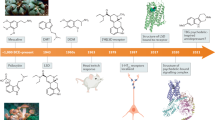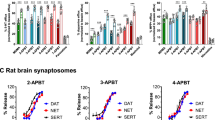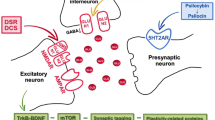Abstract
Deprenyl/Selegiline (DEP), created by Joseph Knoll in the 1960s, registered in more than 60 countries to treat Parkinson’s disease, Alzheimer’s disease, major depressive disorder; and used as an anti-aging drug, achieved its place in research and therapy as the first selective inhibitor of B-type monoamine oxidase (MAO-B). The demonstration that the DEP analog (−)-1-phenyl-2-propylaminopentane devoid of MAO inhibitory property, enhanced like DEP the activity of the catecholaminergic brain engine revealed that this effect is unrelated to the selective inhibition of MAO-B. β-Phenylethylamine (PEA), the important trace-amine in the mammalian brain, is known to be a releaser of catecholamines. Amphetamine and methamphetamine, the best known synthetic PEA derivatives are also releasers of catecholamines like their parent compound. DEP is a unique synthetic PEA derivative devoid of the catecholamine releasing property. As the releasing effect conceals the catecholaminergic activity enhancer (CAE) effect, it remained undiscovered until DEP uncovered that PEA is a natural CAE substance; and only releases catecholamines in high concentration. Discovering that tryptamine is a natural enhancer of catecholaminergic and serotonergic neurons catalyzed the development of R-(−)-1-(benzofuran-2-yl)-2-propylaminopentane (BPAP); the most potent and selective enhancer substance, and it exerts its enhancer effect in 0.0001 mg kg−1. DEP and BPAP initiated an analysis of the enhancer regulation in the mammalian brain. Studies regarding the nature of the enhancer regulation revealed that this regulation is enhanced after weaning and sex hormones return it to the pre-weaning level. Thus, sex hormones elicit the transition of the developmental phase of life into the post-developmental, downhill (aging) period. The aging-related, slow decline in the enhancer regulation of the catecholaminergic brain engine, the main activator of the cortex, is the prime factor of brain aging. The enhancer regulation’s decay in the most rapidly aging dopaminergic system is, for example, mainly responsible for the decline in learning ability and sexual activity over time. According to the Knoll concept, based on two longevity studies performed on male rats, to keep the catecholaminergic brain engine, from the beginning of the downhill period of life, via the administration of a small daily dose of a CAE substance (presently DEP is the only available drug) on a higher activity level, thus to fight against the physiological aging-related slow decay of the catecholaminergic system, is a suitable anti-aging therapy. As our present knowledge regarding the enhancer regulation in the mammalian brain is like seeing a peak of an iceberg, the future of this new line of brain research looks promising from both theoretical and practical aspects.
This is a preview of subscription content, access via your institution
Access options
Subscribe to this journal
Receive 12 print issues and online access
$259.00 per year
only $21.58 per issue
Buy this article
- Purchase on Springer Link
- Instant access to full article PDF
Prices may be subject to local taxes which are calculated during checkout
Similar content being viewed by others
References
Knoll J, Ecseri Z, Kelemen K, Nievel J, Knoll B . Phenylisopropylmethyl propinylamine (E-250) a new psychic energizer. Arch Int Pharmacodyn Ther 1965; 155: 154–164.
Varga E, Tringer L . Clinical trial of a new type of promptly acting psychoenergetic agent (phenyl-isopropylmethyl-propinylamine HCl, E-250). Acta Med Acad Sci Hung 1967; 23: 289–295.
Tringer L, Haits G, Varga E. The effect of (-)E-250, (-)L-phenyl-isopropylmethyl- propinyl-amine HCl, in depression’. In: Leszkovszky G (ed). V. Conferentia Hungarica pro Therapia et Investigatione in Pharmacologia. Publishing House of the Hungarian Academy of Sciences: Budapest, Hungary, 1971, pp 111–114.
Mann JJ, Gershon S . A selective monoamine oxidase-B inhibitor in endogenous depression. Life Sci 1980; 26: 877–882.
Bodkin JA, Amsterdam JK . Transdermal selegiline in major depression: a double-blind, placebo-controlled, parallel-group study in outpatients. Am J Psych 2002; 159: 1869–1875.
Blackwell B . Hypertensive crisis due to monoamine oxidase inhibitors. Lancet 1963; ii: 849–851.
Knoll J, Vizi ES, Somogyi G . Phenylisopropylmethylpropinylamine (E-250), a monoamine oxidase inhibitor antagonizing the effects of tyramine. Arzneim Forsch 1968; 18: 109–112.
Elsworth JD, Glover V, Reynolds GP, Sandler M, Lees AJ, Phuapradit P et al. Deprenyl administration in man: a selective monoamine oxidase B inhibitor without the ‘cheese effect’. Psychopharmacology 1978; 57: 33–38.
Sandler M, Glover V, Ashford A, Stern GM . Absence of ‘cheese effect’ during deprenyl therapy: some recent studies. J Neural Transm 1978; 43: 209–215.
Birkmayer W, Riederer P, Ambrozi L . Youdim MBH. Implications of combined treatment with ‘Madopar’ and L-Deprenil in Parkinson's disease. Lancet 1977; 1: 439–443.
Knoll J, Magyar K . Some puzzling effects of monoamine oxidase inhibitors. Adv Biochem Psychopharmacol 1972; 5: 393–408.
Birkmayer W, Hornykiewicz O . Der L-dioxyphenyl-alanin-effekt beim Parkinson syndrom des Menschen. Arch Psychiat Nervenkrh 1962; 203: 560–564.
Harsing RG, Magyar K, Tekes K, Vizi ES, Knoll J . Inhibition by (-)-deprenyl of dopamine uptake in rat striatum: a possible correlation between dopamine uptake and acetylcholine release inhibition. Pol J Pharm Pharmacy 1979; 31: 297–307.
Knoll J . R-(-)Deprenyl (Selegiline, MoverganR facilitates the activity of the nigrostriatal dopaminergic neuron. J Neural Transm 1987; 25: 45–66.
Knoll J . The striatal dopamine dependency of lifespan in male rats. Longevity study with (-)deprenyl. Mech Ageing Dev 1988; 46: 237–262.
Knoll J . Selective inhibition of B type monoamine oxidase in the brain: a drug strategy to improve the quality of life in senescence. In: Keverling Buisman JA (ed). Strategy in Drug Research. Elsevier: Amsterdam, Netherlands, 1982, pp 107–135.
Knoll J . The facilitation of dopaminergic activity in the aged brain by (-)deprenyl. A proposal for a strategy to improve the quality of life in senescence. Mech Ageing Dev 1985; 30: 109–122.
Riederer P, Wuketich S . Time course of nigrostriatal degeneration in Parkinson's disease. J Neural Transm 1976; 38: 277–301.
Fowler CJ, Wiberg A, Oreland L, Winblad B . The effect of age on the activity and molecular properties of human brain monoamine oxidase. J Neural Transm 1980; 49: 1–20.
McGeer EG, McGeer PL, Wada JK . Distribution of tyrosine hydroxylase in human and animal brain. J Neurochem 1971; 18: 1647–1658.
Birkmayer W, Knoll J, Riederer P, Youdim MB, Hars V, Marton J . Increased life expectancy resulting from addition of L-deprenyl to Madopar treatment in Parkinson's disease: a longterm study. J Neural Transm 1985; 64: 113–127.
Knoll J, Dalló J, Yen TT . Striatal dopamine, sexual activity and lifespan. Longevity of rats treated with (-)deprenyl. Life Sci 1989; 45: 525–531.
Knoll J . The pharmacology of selegiline /(-)deprenyl/. Acta Neurol Scand 1989; 126: 83–91.
Carrillo MC, Kanai S, Nokubo M, Kitani K . (-)Deprenyl induces activities of both superoxide dismutase and catalase but not of glutathion peroxidase in the striatum of young male rats. Life Sci 1991; 48: 517–521.
Knoll J . Memories of my 45 years in research. Pharmacol Toxicol 1994; 75: 65–72.
Knoll J, Yen TT, Miklya I . Sexually low performing male rats die earlier than their high performing peers and (-)deprenyl treatment eliminates this difference. Life Sci 1994; 54: 1047–1057.
Tetrud JW, Langston JW . The effect of (-)deprenyl (selegiline) on the natural history of Parkinson's disease. Science 1989; 245: 519–522.
Parkinson Study Group. Effect of (-)deprenyl on the progression disability in early Parkinson's disease. New Eng J Med 1989; 321: 1364–1371.
Knoll J . Pharmacological basis of the therapeutic effect of (-)deprenyl in age-related neurological diseases. Med Res Rev 1992; 12: 505–524.
Knoll J . (-)Deprenyl-medication: a strategy to modulate the age-related decline of the striatal dopaminergic system. J Am Ger Soc 1992; 40: 839–847.
Knoll J, Knoll B, Török Z, Timár J, Yasar S . The pharmacology of 1-phenyl-2-propylaminopentane (PPAP), a deprenyl-derived new spectrum psychostimulant. Arch Int Pharmacodyn Ther 1992; 316: 5–29.
Miklya I, Knoll B, Knoll J . A pharmacological analysis elucidating why, in contrast to (-)-deprenyl (selegiline) α-tocopherol was ineffective in the DATATOP study. Life Sci 2003; 72: 2641–2648.
Miklya I . The Knoll-concept to decrease the prevalence of Parkinson’s disease, Chapter 5. In: Finkelstein DI (ed). Towards New Therapies for Parkinson’s Disease. InTech Open Access Publisher: Rijeka, Croatia, 2011, pp 77–100.
Miklya I . Essential difference between the pharmacological spectrum of (-)-deprenyl and rasagiline. Pharmacol Rep 2014; 66: 453–458.
Parkinson Study Group. A controlled trial of rasagiline in early Parkinson disease: the TEMPO study. Arch Neurol 2002; 59: 1937–1943.
Knoll J, Tóth V, Kummert M, Sugár J . (-)Deprenyl and (-)parafluorodeprenyl-treatment prevents age-related pigment changes in the substantia nigra. A TV-image analysis of neuromelanin. Mech Ageing Dev 1992; 63: 157–163.
Knoll J, Miklya I . Multiple, small dose administration of (-)deprenyl enhances catecholaminergic activity and diminishes serotoninergic activity in the brain and these effects are unrelated to MAO-B inhibition. Arch Int Pharmacodyn Ther 1994; 328: 1–15.
Knoll J, Miklya I . Enhanced catecholaminergic and serotoninergic activity in rat brain from weaning to sexual maturity. Rationale for prophylactic (-)deprenyl (selegiline) medication. Life Sci 1995; 56: 611–620.
Knoll J, Miklya I, Knoll B, Markó R, Rácz D . Phenylethylamine and tyramine are mixed-acting sympathomimetic amines in the brain. Life Sci 1996; 58: 2101–2114.
Knoll J . How Selegiline /(-)-Deprenyl Slows Brain Aging. Bentham Science Publishers: E-book, Sharjah, United Arab Emirates, 2012.
Martini E, Pataky I, Szilágyi K, Venter V . Brief information on an early phase-II study with (-)deprenyl in demented patients. Pharmacopsychiatry 1987; 20: 256–257.
Tariot PN, Cohen RM, Sunderland T, Newhouse PA, Yount D . Mellow AM. L-(-)Deprenyl in Alzheimer's disease. Arch Gen Psych 1987; 44: 427–433.
Sano M, Ernesto C, Thomas RG, Klauber MR, Schafer K, Grundman M et al. A controlled trial of selegiline, alpha-tocopherol, or both as treatment for Alzheimer’s disease. New Eng J Med 1997; 336: 1216–1222.
Wilcock GK, Birks J, Whitehead A, Evans SJ . The effect of selegiline in the treatment of people with Alzheimer’s disease: a meta-analysis of published trials. Int J Geriatr Psychiatry 2002; 17: 175–183.
Milgram NW, Ivy GO, Head E, Murphy PM, Wu PH, Ruehl WW et al. The effect of L-deprenyl on behavior, cognitive function, and biogenic amines in the dog. Neurochem Res 1993; 18: 1211–1219.
Knoll J, Yoneda F, Knoll B, Ohde H, Miklya I . (-)l-(Benzofuran-2-yl)-2-propylaminopentane, [(-)BPAP], a selective enhancer of the impulse propagation mediated release of catecholamines and serotonin in the brain. Br J Pharmacol 1999; 128: 1723–1732.
Knoll J, Miklya I, Knoll B . Stimulation of the catecholaminergic and serotoninergic neurons in the rat brain by R-(-)-1-(benzofuran-2-yl)-2-propylaminopentane, (-)-BPAP. Life Sci 2002; 71: 2137–2144.
Knoll J, Miklya I, Knoll B, Dalló J . Sexual hormones terminate in the rat the significantly enhanced catecholaminergic/serotoninergic tone in the brain characteristic to the post-weaning period. Life Sci 2000; 67: 765–773.
Knoll J . (-)Deprenyl (selegiline) a catecholaminergic activity enhancer (CAE) substance acting in the brain. Pharmacol Toxicol 1998; 82: 57–66.
Knoll J . Antiaging compounds: (-)Deprenyl (Selegiline) and (-)1-(benzofuran-2-yl)-2-propylaminopentane, (-)BPAP, a selective highly potent enhancer of the impulse propagation mediated release of catecholamines and serotonin in the brain. CNS Drug Rev 2001; 7: 317–345.
Knoll J . Enhancer regulation/endogenous and synthetic enhancer compounds: a neurochemical concept of the innate and acquired drives. Neurochem Res 2003; 28: 1187–1209.
Knoll J . The Brain and Its Self. A Neurochemical Concept of the Innate and Acquired Drives. Springer: Berlin, Heidelberg, Germany, New York, USA, 2005.
Knoll J, Miklya I, Knoll B, Yasusa T, Shimazu S, Yoneda F . 1-(Benzofuran-2-yl)-2-(3,3,3-trifluoropropyl)aminopentane HCl, 3- F-BPAP, antagonizes the enhancer effect of (-)-BPAP in the shuttle box and leaves the effect of (-)-deprenyl unchanged. Life Sci 2002; 71: 1975–1984.
Knoll J . The Theory of Active Reflexes. An analysis of Some Fundamental Mechanisms of Higher Nervous Activity. Hafner Publishing Company: New York, USA, 1969.
Acknowledgements
The author of this paper, one of his coworkers, who was lucky to join his staff 35 years ago and still has the privilege to work with him daily in his lab, congratulates Professor József Knoll, a pioneer of neuro-psychopharmacology, on his 90th birthday. There can be little doubt that Professor Knoll’s life work summarized in his monographs40,52,54 provides the everlasting effort of science to improve the quality and duration of human life with a hopeful new basis.
Author information
Authors and Affiliations
Corresponding author
Ethics declarations
Competing interests
The author declares no conflict of interest.
Rights and permissions
About this article
Cite this article
Miklya, I. The significance of selegiline/(−)-deprenyl after 50 years in research and therapy (1965–2015). Mol Psychiatry 21, 1499–1503 (2016). https://doi.org/10.1038/mp.2016.127
Received:
Revised:
Accepted:
Published:
Issue Date:
DOI: https://doi.org/10.1038/mp.2016.127
This article is cited by
-
A sustainable avenue for the synthesis of propargylamines and benzofurans using a Cu-functionalized MIL-101(Cr) as a reusable heterogeneous catalyst
Scientific Reports (2023)
-
Multiomic Analyses of Dopaminergic Neurons Isolated from Human Substantia Nigra in Parkinson’s Disease: A Descriptive and Exploratory Study
Cellular and Molecular Neurobiology (2022)
-
β-Amyloid and Lithium Affect the Magnitude of Phasic Dopamine Release in the Shell of the Nucleus Accumbens
Neuroscience and Behavioral Physiology (2021)
-
Presentations to an urban emergency department in Bern, Switzerland associated with acute recreational drug toxicity
Scandinavian Journal of Trauma, Resuscitation and Emergency Medicine (2017)



